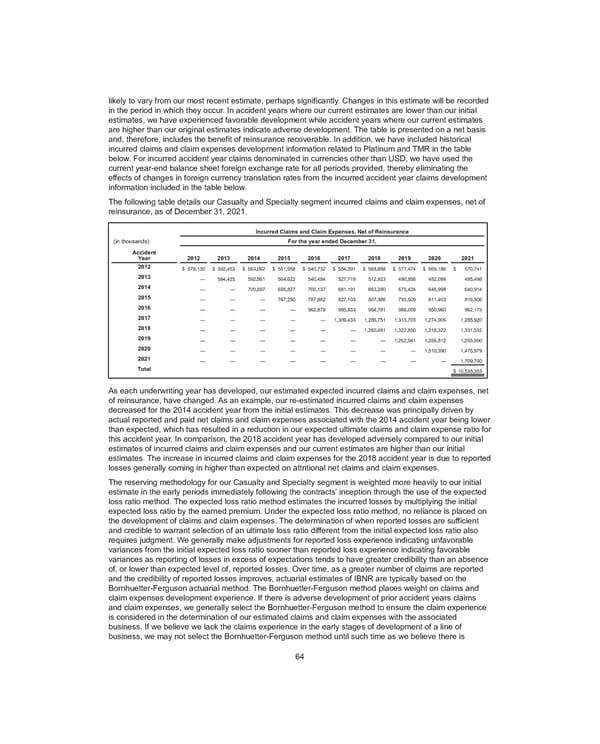likely to vary from our most recent estimate, perhaps significantly. Changes in this estimate will be recorded in the period in which they occur. In accident years where our current estimates are lower than our initial estimates, we have experienced favorable development while accident years where our current estimates are higher than our original estimates indicate adverse development. The table is presented on a net basis and, therefore, includes the benefit of reinsurance recoverable. In addition, we have included historical incurred claims and claim expenses development information related to Platinum and TMR in the table below. For incurred accident year claims denominated in currencies other than USD, we have used the current year-end balance sheet foreign exchange rate for all periods provided, thereby eliminating the effects of changes in foreign currency translation rates from the incurred accident year claims development information included in the table below. The following table details our Casualty and Specialty segment incurred claims and claim expenses, net of reinsurance, as of December 31, 2021. Incurred Claims and Claim Expenses, Net of Reinsurance (in thousands) For the year ended December 31, Accident Year 2012 2013 2014 2015 2016 2017 2018 2019 2020 2021 2012 $ 578,130 $ 592,453 $ 563,062 $ 551,958 $ 540,732 $ 554,391 $ 568,888 $ 577,474 $ 569,186 $ 570,741 2013 — 594,425 592,861 564,622 540,484 527,719 512,923 490,856 482,099 485,498 2014 — — 700,597 695,827 700,137 681,191 663,280 675,424 646,998 640,914 2015 — — — 767,250 787,882 827,103 807,386 793,509 811,403 816,906 2016 — — — — 962,878 995,833 994,781 986,009 950,960 962,173 2017 — — — — — 1,309,433 1,286,751 1,313,703 1,274,909 1,285,920 2018 — — — — — — 1,260,481 1,322,850 1,318,322 1,331,532 2019 — — — — — — — 1,262,941 1,256,812 1,255,990 2020 — — — — — — — — 1,510,390 1,475,979 2021 — — — — — — — — — 1,709,700 Total $ 10,535,353 As each underwriting year has developed, our estimated expected incurred claims and claim expenses, net of reinsurance, have changed. As an example, our re-estimated incurred claims and claim expenses decreased for the 2014 accident year from the initial estimates. This decrease was principally driven by actual reported and paid net claims and claim expenses associated with the 2014 accident year being lower than expected, which has resulted in a reduction in our expected ultimate claims and claim expense ratio for this accident year. In comparison, the 2018 accident year has developed adversely compared to our initial estimates of incurred claims and claim expenses and our current estimates are higher than our initial estimates. The increase in incurred claims and claim expenses for the 2018 accident year is due to reported losses generally coming in higher than expected on attritional net claims and claim expenses. The reserving methodology for our Casualty and Specialty segment is weighted more heavily to our initial estimate in the early periods immediately following the contracts’ inception through the use of the expected loss ratio method. The expected loss ratio method estimates the incurred losses by multiplying the initial expected loss ratio by the earned premium. Under the expected loss ratio method, no reliance is placed on the development of claims and claim expenses. The determination of when reported losses are sufficient and credible to warrant selection of an ultimate loss ratio different from the initial expected loss ratio also requires judgment. We generally make adjustments for reported loss experience indicating unfavorable variances from the initial expected loss ratio sooner than reported loss experience indicating favorable variances as reporting of losses in excess of expectations tends to have greater credibility than an absence of, or lower than expected level of, reported losses. Over time, as a greater number of claims are reported and the credibility of reported losses improves, actuarial estimates of IBNR are typically based on the Bornhuetter-Ferguson actuarial method. The Bornhuetter-Ferguson method places weight on claims and claim expenses development experience. If there is adverse development of prior accident years claims and claim expenses, we generally select the Bornhuetter-Ferguson method to ensure the claim experience is considered in the determination of our estimated claims and claim expenses with the associated business. If we believe we lack the claims experience in the early stages of development of a line of business, we may not select the Bornhuetter-Ferguson method until such time as we believe there is 64
 2021 Annual Report Page 79 Page 81
2021 Annual Report Page 79 Page 81